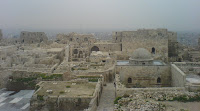The Citadel of Aleppo is an important tourist attraction which is a site of archaeological digs and studies. It is a large medieval fortified palace in the centre of the old city of Aleppo, northern Syria. The Citadel hill dates back to middle of the 3rd millennium BC. It is occupied by many civilizations including the Greeks, Byzantines, Ayyubids and Mamluks, the majority of the construction as it stands today is thought to originate from the Ayyubid period. A great deal of protection work has taken place in the 2000s by Aga Khan Trust for Culture in collaboration with the Syrian Directorate General of Antiquities.
 The Citadel is situated on a mound which has an elliptical base with a length of 450m and width of 325m. At the top this ellipse measures 285m by 160m with the height of this slanting foundation measuring 50m. The entire mound was covered with large blocks of gleaming limestone, some of which still remain today. The mound is surrounded by a 22m-deep and 30m-wide moat, dating from the 12th century. Notable is the fortified gateway, accessible though an arched bridge. This feature was an addition from the Mamluk government in the 16th century. A succession of five right-angle turns and three large gates with carved figures directs to main inner castle entrance. The interior are the Weapons Hall, the Byzantine Hall and the Throne Hall, with a restored decorated ceiling. The amphitheater is often used for musical concerts or cultural events.
The Citadel is situated on a mound which has an elliptical base with a length of 450m and width of 325m. At the top this ellipse measures 285m by 160m with the height of this slanting foundation measuring 50m. The entire mound was covered with large blocks of gleaming limestone, some of which still remain today. The mound is surrounded by a 22m-deep and 30m-wide moat, dating from the 12th century. Notable is the fortified gateway, accessible though an arched bridge. This feature was an addition from the Mamluk government in the 16th century. A succession of five right-angle turns and three large gates with carved figures directs to main inner castle entrance. The interior are the Weapons Hall, the Byzantine Hall and the Throne Hall, with a restored decorated ceiling. The amphitheater is often used for musical concerts or cultural events.The enormous stone bridge constructed by Sultan Ghazi over the moat led to an imposing entrance complex. Would-be assailants to the castle would have to take over six turns up a vaulted entrance ramp, over which were machicolations for pouring hot liquids on attackers from the mezzanine above. Secret passageways wind through the complex, and the main passages are decorated with figurative reliefs. The Ayyubid block is topped by the Mamluk ‘Throne Hall,’ a hall where Mamluk sultans entertained large audiences and held official functions.


Ghazi’s famous ‘palace of glory’ tragically burned down on his wedding night, but it was later rebuilt and today stands as one of the most important and impressive monuments in the citadel crown. The Ayyubids were not the first to build a palace on the citadel. Today, many fine architectural details remain from the Ayyubid period, including a spectacular entrance portal with muqarnas, or honeycomb vaulting, and a courtyard on the four-iwan system, with beautiful tiling. Laid out in traditional medieval Islamic style, the palace hammam has three sections. The first was used for dressing, undressing, and resting. The second was an unheated but warmer room, and a steam room equipped with alcoves. Hot and cold water was piped through to the hammam with earthenware pipes.
By no means was construction in the citadel confined to above-ground. Several wells penetrate down to 125m below the surface of the crown. Underground passageways connect to the advance towers and possibly under the moat to the city.
Post Title
→Aleppo Citadel in Aleppo
Post URL
→http://guidice-galleries.blogspot.com/2009/12/aleppo-citadel-in-aleppo.html
Visit guidice galleries for Daily Updated Wedding Dresses Collection








